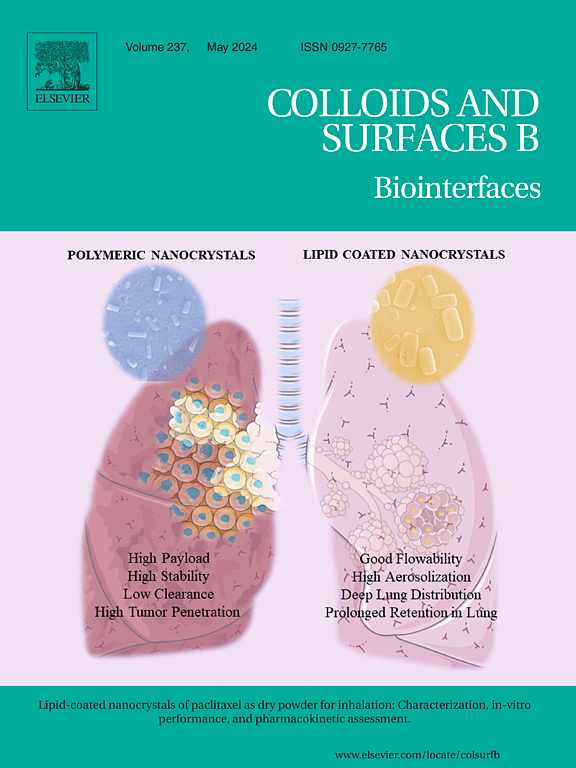乳清蛋白和酪蛋白酸钠在胶体氧化铬上的吸附作为钢的预结垢模型
IF 5.4
2区 医学
Q1 BIOPHYSICS
引用次数: 0
摘要
用于巴氏灭菌的不锈钢热交换器的污垢是乳制品行业的一个问题。厚的,富含蛋白质的层必须定期去除,以防止减少液体和热量的流动和生物危害。我们假设最初的单层蛋白质的吸附是由静电相互作用驱动的。实验在室温和pH 3 ~ 7条件下,研究了胶体氧化铬(Cr2O3)与乳清蛋白或酪蛋白酸钠的混合物。胶体Cr2O3的表面类似于不锈钢的钝化层,其本质上由Cr2O3组成。通过光学显微镜、动态光散射和分析离心来评估吸附蛋白质对胶体Cr2O3的稳定性。测定了zeta电位和吸附等温线。尽管Cr2O3的等电点为pH 2或更高,蛋白质的等电点为pH 5,但吸附蛋白质对Cr2O3的胶体稳定在很大程度上与pH无关,尽管Cr2O3和蛋白质的表面电荷密度在我们的实验pH范围内强烈依赖于pH。不考虑pH值,吸附等温线表明,第一层部分单层蛋白被不可逆吸附。我们得出结论,蛋白质在不锈钢上的最初吸附可能不是由静电驱动的,而是由范德华作用或疏水相互作用驱动的。本文章由计算机程序翻译,如有差异,请以英文原文为准。
Adsorption of whey protein and sodium caseinate onto colloidal chromium oxide as a model for the pre-fouling of steel
Hypothesis
The fouling of stainless-steel heat exchangers used in pasteurization is a problem in the dairy industry. Thick, protein-rich layers must regularly be removed to prevent reduced flow of liquid and heat and biological hazards. We hypothesized that the adsorption of an initial monolayer of proteins is driven by electrostatic interactions.
Experiments
Mixtures of colloidal chromium oxide (Cr2O3) and whey proteins or sodium caseinate were studied at room temperature and pH 3–7. The surface of colloidal Cr2O3 resembles the passivation layer of stainless steel, which essentially consists of Cr2O3. Stabilization of colloidal Cr2O3 by adsorbed proteins was evaluated using optical microscopy, dynamic light scattering, and analytical centrifugation. Moreover, zeta potentials and adsorption isotherms were measured.
Findings
Despite isoelectric points at pH 2 or higher for Cr2O3 and pH 5 for the proteins, the colloidal stabilization of Cr2O3 by adsorbed proteins was largely pH-independent, even though the surface charge densities of Cr2O3 and the proteins strongly depend on pH in our experimental pH range. Irrespective of pH, the adsorption isotherms demonstrated that a first partial monolayer of proteins was adsorbed irreversibly. We conclude that the initial adsorption of proteins onto stainless steel is probably not driven by electrostatics but by Van der Waals or hydrophobic interactions.
求助全文
通过发布文献求助,成功后即可免费获取论文全文。
去求助
来源期刊

Colloids and Surfaces B: Biointerfaces
生物-材料科学:生物材料
CiteScore
11.10
自引率
3.40%
发文量
730
审稿时长
42 days
期刊介绍:
Colloids and Surfaces B: Biointerfaces is an international journal devoted to fundamental and applied research on colloid and interfacial phenomena in relation to systems of biological origin, having particular relevance to the medical, pharmaceutical, biotechnological, food and cosmetic fields.
Submissions that: (1) deal solely with biological phenomena and do not describe the physico-chemical or colloid-chemical background and/or mechanism of the phenomena, and (2) deal solely with colloid/interfacial phenomena and do not have appropriate biological content or relevance, are outside the scope of the journal and will not be considered for publication.
The journal publishes regular research papers, reviews, short communications and invited perspective articles, called BioInterface Perspectives. The BioInterface Perspective provide researchers the opportunity to review their own work, as well as provide insight into the work of others that inspired and influenced the author. Regular articles should have a maximum total length of 6,000 words. In addition, a (combined) maximum of 8 normal-sized figures and/or tables is allowed (so for instance 3 tables and 5 figures). For multiple-panel figures each set of two panels equates to one figure. Short communications should not exceed half of the above. It is required to give on the article cover page a short statistical summary of the article listing the total number of words and tables/figures.
 求助内容:
求助内容: 应助结果提醒方式:
应助结果提醒方式:


